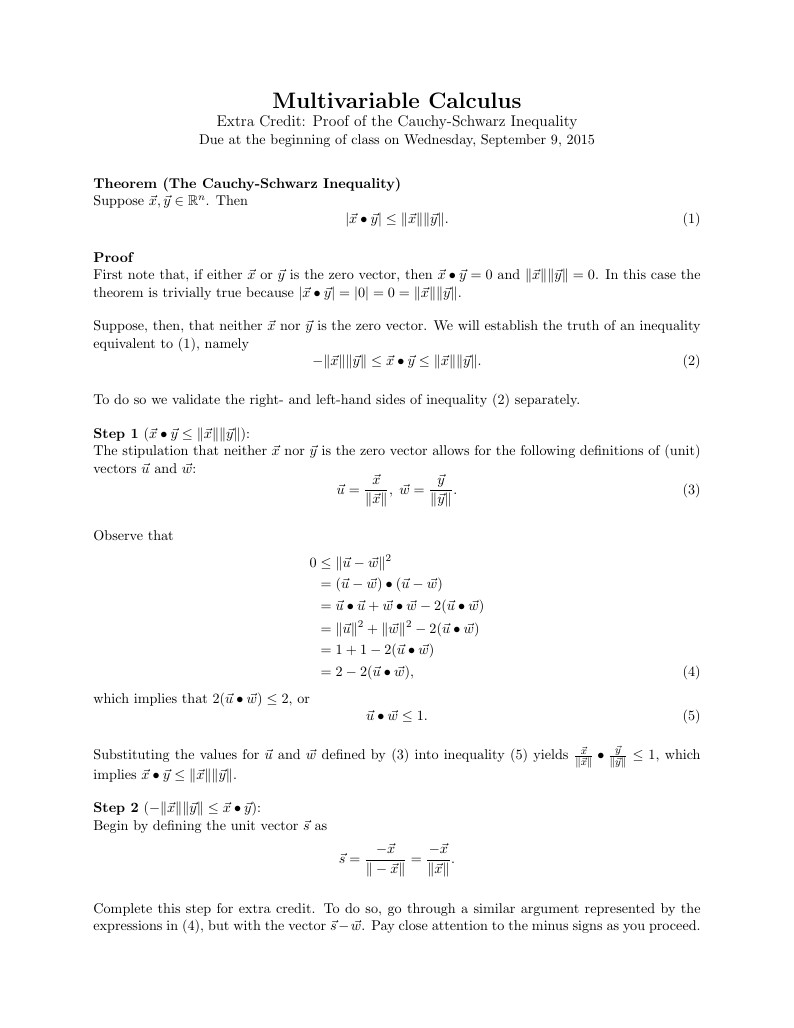
Cauchy-Schwarz Inequality
Author:
Russell Howell
Last Updated:
10 лет назад
License:
Creative Commons CC BY 4.0
Аннотация:
For use as a class exercise.

\begin
Discover why over 20 million people worldwide trust Overleaf with their work.
For use as a class exercise.

\begin
Discover why over 20 million people worldwide trust Overleaf with their work.
\documentclass[11pt]{article}
\usepackage{geometry, amsmath, amsthm, latexsym, amssymb, graphicx}
\geometry{margin=1in, headsep=0.25in}
\parindent 0in
\parskip 12pt
\begin{document}
\title{Cauchy-Schwarz Inequality}
\thispagestyle{empty}
\begin{center}
{\LARGE \bf Multivariable Calculus}\\
{\large Extra Credit: Proof of the Cauchy-Schwarz Inequality}\\
Due at the beginning of class on Wednesday, September 9, 2015
\end{center}
\textbf{Theorem (The Cauchy-Schwarz Inequality)}\\
Suppose $\vec{x},\vec{y} \in \mathbb{R}^n$. Then
\begin{equation}
|\vec{x} \bullet \vec{y}| \le \|\vec{x}\| \|\vec{y}\| \label{cs-ineq}.
\end{equation}
\textbf{Proof}\\
First note that, if either $\vec{x}$ or $\vec{y}$ is the zero vector,
then $\vec{x} \bullet \vec{y} = 0$ and $\|\vec{x}\| \|\vec{y}\| = 0$.
In this case the theorem is trivially true because
$|\vec{x} \bullet \vec{y}| = |0| = 0 = \|\vec{x}\| \|\vec{y}\|$.
Suppose, then, that neither $\vec{x}$ nor $\vec{y}$ is the zero vector.
We will establish the truth of an inequality equivalent to \eqref{cs-ineq},
namely
\begin{equation}
-\|\vec{x}\| \|\vec{y}\| \le \vec{x} \bullet \vec{y} \le
\|\vec{x}\| \|\vec{y}\|. \label{cs-ineq-alt}
\end{equation}
To do so we validate the right- and left-hand sides of inequality
\eqref{cs-ineq-alt} separately.
\textbf{Step 1} ($\vec{x} \bullet \vec{y} \le \|\vec{x}\| \|\vec{y}\|$):\\
The stipulation that neither $\vec{x}$ nor $\vec{y}$ is the zero vector
allows for the following definitions of (unit) vectors $\vec{u}$ and $\vec{w}$:
\begin{equation}
\vec{u} = \frac{\vec{x}}{\|\vec{x}\|}, \; \vec{w} =
\frac{\vec{y}}{\|\vec{y}\|}. \label{def1}
\end{equation}
Observe that
\begin{align}
0 & \le \|\vec{u}-\vec{w}\|^2 \notag\\
& =(\vec{u}-\vec{w}) \bullet (\vec{u}-\vec{w}) \notag\\
& = \vec{u} \bullet \vec{u} + \vec{w} \bullet \vec{w} - 2(\vec{u}\bullet\vec{w}) \notag\\
& = \|\vec{u}\|^2 + \|\vec{w}\|^2 - 2(\vec{u} \bullet \vec{w}) \notag\\
& = 1 + 1 - 2(\vec{u} \bullet \vec{w}) \notag\\
& = 2 - 2(\vec{u} \bullet \vec{w}) \label{eq1},
\end{align}
which implies that $2(\vec{u} \bullet \vec{w}) \le 2$, or
\begin{equation}
\vec{u} \bullet \vec{w} \le 1. \label{final}
\end{equation}
Substituting the values for $\vec{u}$ and $\vec{w}$ defined by \eqref{def1}
into inequality \eqref{final} yields $\frac{\vec{x}}{\|\vec{x}\|} \bullet
\frac{\vec{y}}{\|\vec{y}\|} \le 1$, which implies $\vec{x} \bullet \vec{y}
\le \|\vec{x}\| \|\vec{y}\|$.
\textbf{Step 2} ($-\|\vec{x}\| \|\vec{y}\| \le \vec{x} \bullet \vec{y}$):\\
Begin by defining the unit vector $\vec{s}$ as
$$\vec{s} = \frac{-\vec{x}}{\|-\vec{x}\|} = \frac{-\vec{x}}{\|\vec{x}\|}.$$
Complete this step for extra credit. To do so, go through a similar argument
represented by the expressions in \eqref{eq1}, but with the vector $\vec{s}-\vec{w}$.
Pay close attention to the minus signs as you proceed.
\clearpage
This is where you should begin Step 2.
\end{document}